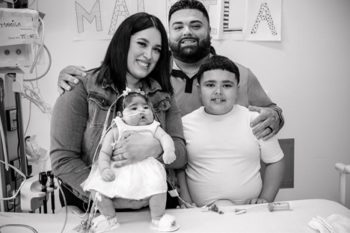On December 30, 2021, Kelsey Schleppy gave birth to her baby girl, Maleila. Within days of taking her home, Kelsey’s intuition told her something wasn’t right. Her family practice doctor assured her Maleila’s shallow breathing and lack of appetite wasn’t anything out of the ordinary, but Kelsey kept a watchful eye, nevertheless. Within a few days of bringing Maleila home, Kelsey noticed Maleila deteriorating rapidly one morning and made the decision to call 911.
By the time they arrived at their local hospital in Skagit Valley, Maleila no longer had a pulse. She was rushed into Emergency Department (ED) where the team performed chest compressions to resuscitate her. The team also needed to give her epinephrine, but the standard method of inserting an IV in a vein in her arm or leg wasn’t working.

At the same time, many miles away, Dr. Rachel Umoren, Medical Director of Inpatient Telehealth at Seattle Children’s and Associate Professor & Associate Division Head for Research, Neonatology at UW, was the scheduled on-call doctor for Seattle Children’s Telehealth Services. She received a call from Skagit Valley Hospital and dialed into the portable device positioned facing Maleila’s bed. “I was looking into the room, and I just remember seeing this iPad screen on wheels,” said Kelsey.
Through the web camera, Dr. Umoren was able to view Maleila over her pediatrician’s shoulder and identified a light pink spot within Maleila’s naval. She recommended they try umbilical vein catheterization (UVC) to get Maleila the life-saving medications she needed.
Umbilical vein catheterization (UVC) utilizes the exposed umbilical stump in newborns as a site for emergency central venous access. UVC can provide a safe and effective route for intravenous delivery of medications and fluids during resuscitation, however it’s typically only effective for infants under a few days old.
Even though Maleila was slightly older than the typical UVC recipient, the delivery worked, and she was able to be stabilized enough to be transported to Seattle Children’s Cardiac Intensive Care Unit (CICU), where she was diagnosed with hypoplastic left heart syndrome, a complex and rare heart defect present at birth. In this condition, the left side of the heart is critically underdeveloped.
Maleila’s road to recovery has been far from easy, but Kelsey continues to be impressed by her daughter’s unwavering strength. Today, Maleila is 8 months old and defying all the odds. “I think a lot of people are shocked and amazed by Maleila’s story. If you look at the statistics, Maleila should not be here. I can’t even put into words how strong this little girl is,” said Kelsey.
Dr. Umoren was able to visit Kelsey and Maleila in the CICU months after she first laid eyes on Maleila in the ED. She was thrilled to see how much Maleila has progressed since she cared for her via telehealth.
Telehealth refers to a broad spectrum of remote technological healthcare services, which may include non-clinical services or delivering clinical care from a distance via technology. Seattle Children’s, a pioneer in the telehealth space for the neonatal subspeciality, recognized more than 20 years ago the importance of being able to provide our standard of care to neonatal patients in our region, no matter how far away they are.
“I am very excited to say we are continuing to expand the units we cover,” said Umoren. “We currently have a full telehealth team of 14 neonatologists specially trained to deliver these unique services. Our team has to be knowledgeable about how to resuscitate, as well as have the ability to remain calm and project their presence even while virtual.”
“The region Seattle Children’s serves covers over a million square miles, and transport times can take hours. Having the ability to call telehealth support within minutes of a baby presenting an emergency is such a valuable tool. It has saved lives. It saved Maleila’s life that day,” said Umoren.

